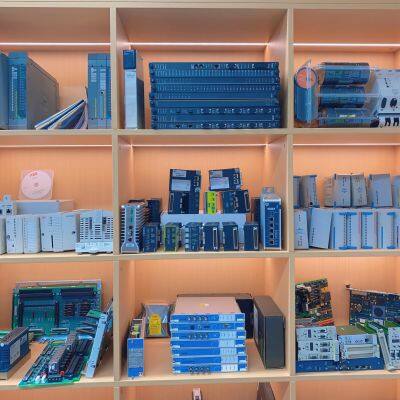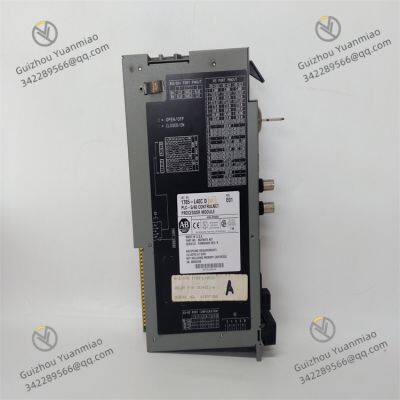Product Description
I. Product Overview
Allen-Bradley 1785-L40C is a high-performance programmable logic controller in the PLC-5 series, which performs excellently in medium and large-scale industrial automation control scenarios. As the core hub of industrial control, it can accurately regulate complex production processes and equipment clusters according to preset programs, promoting the production process towards a high degree of automation and intelligence, thereby significantly improving production efficiency, reducing labor costs, and ensuring the stability of product quality.
This controller inherits the modular design concept of the PLC-5 series, with a compact structure and reasonable layout. It can flexibly be compatible with various I/O modules, communication modules, special function modules, etc., and can be personalized configured according to the control needs of different industrial fields. Its shell is made of high-strength, corrosion-resistant industrial-grade alloy materials, with excellent anti-vibration and anti-impact performance. At the same time, through professional sealing design, it achieves good dust-proof and moisture-proof effects. It can operate stably for a long time in complex and harsh industrial field environments such as high temperature, dusty, humid, and electromagnetic interference, ensuring the uninterrupted execution of control tasks.
In the industrial automation system architecture, 1785-L40C assumes key responsibilities such as data collection, logical operation, control instruction generation and output, and equipment status monitoring. It is an important bridge connecting the underlying on-site equipment and the upper management system, providing a solid control support for the safe, stable, and efficient operation of industrial production.

II. Performance Parameters
(1) Processor and Memory
1785-L40C is equipped with a high-performance microprocessor with strong computing power. Compared with some models in the same series, its instruction execution speed is faster. It can complete the collection of a large number of input signals, complex logical operations, and the generation of output control instructions within milliseconds, fully meeting the strict real-time requirements of medium and large-scale industrial control projects.
In terms of memory configuration, the controller has a larger capacity of user program memory and data memory. The user program memory can accommodate complex control programs with tens of thousands of instructions, which is sufficient to meet the control needs of multi-process and multi-equipment collaborative work; the data memory provides sufficient space for real-time data storage, which can store massive on-site collected data (such as temperature, pressure, flow, liquid level, etc.), intermediate operation results, equipment operation parameters, fault records and other information, ensuring the efficient processing and management of data by the control system.
(2) Power Supply Characteristics
1785-L40C has strong adaptability to power input, supporting a wide range of AC power input, usually 85-264V AC. It can adapt to grid voltage fluctuations in different regions around the world without the need for additional voltage conversion equipment. It has a stable DC power output function, which can provide various specifications of DC power such as +5V DC and +24V DC for itself and various connected modules, and the output current capacity is large, which can meet the power demand of multiple modules working at the same time.
The power protection mechanism is perfect, with overvoltage protection, overcurrent protection, short-circuit protection, undervoltage protection and other functions. When the power supply system is abnormal, the controller will quickly start protection measures, such as cutting off the output power, sending out alarm signals, etc., to prevent damage to the controller and related equipment due to power supply failures, which greatly improves the safety and reliability of the system.
(3) I/O Capability
1785-L40C has outstanding I/O expansion capability. It can connect a large number of I/O modules through multiple expansion racks, supporting the processing of various types of signals such as digital, analog, and pulse. The maximum expandable I/O points are significantly higher than the small controllers in the same series, which can meet the control needs of large production lines and complex industrial equipment clusters. For example, an automobile welding production line with dozens of equipment and hundreds of detection points, its I/O needs can be fully met through the expansion capability of 1785-L40C.
Digital I/O modules can realize precise control and status collection of switching devices such as contactors, relays, buttons, and indicator lights; analog I/O modules can perform high-precision collection and control of standard analog signals such as 4-20mA and 0-10V output by temperature transmitters, pressure sensors, flow sensors and other equipment; some special I/O modules can also realize functions such as high-speed counting and pulse output, meeting the control needs of servo motors, stepping motors and other equipment.
(4) Communication Interfaces
1785-L40C is equipped with more abundant communication interfaces. In addition to the common RS-232 and RS-485 serial communication interfaces, it may also include an Ethernet interface (some models), supporting multiple mainstream industrial communication protocols such as DF1, DH+ (Data Highway Plus), and EtherNet/IP.
Through these communication interfaces, 1785-L40C can realize efficient data interaction with programming terminals, human-machine interfaces (HMI), other PLCs (including the same brand and some different brands), SCADA systems, MES systems, etc. For example, connecting with the upper computer system through the Ethernet interface can realize functions such as remote upload and download of control programs, real-time upload of production data, remote monitoring and diagnosis, which greatly improves the integration and intelligent management level of industrial automation systems.
(5) Environmental Adaptability
Operating temperature: The operating temperature range of 1785-L40C is usually 0°C to 60°C. In extreme cases, some models can run for a short time in the range of -20°C to 70°C, which can adapt to the high temperature in summer, low temperature in winter in industrial workshops, and local high temperature environment caused by equipment heat dissipation.
Relative humidity: It can work stably in an environment with a relative humidity of 5%-95% (non-condensing), and is suitable for industrial fields with high humidity such as food processing, textiles, papermaking, and water treatment, effectively avoiding problems such as circuit short circuits and component rust caused by moisture.
Anti-electromagnetic interference: It has passed strict industrial-grade electromagnetic compatibility certification, with extremely strong anti-electromagnetic interference ability. It can resist strong electromagnetic radiation interference generated by motors, frequency converters, electric welders, high-voltage equipment, etc. in industrial sites, ensuring the normal operation of control programs and the accuracy of data transmission.
Anti-vibration and impact resistance: It can withstand vibration with a frequency of 10-500Hz and an amplitude of 0.38mm, and an impact with an acceleration of 15g (duration of 11ms). It is suitable for industrial environments with strong vibration and impact such as machine tool processing, heavy machinery manufacturing, and rail transit supporting equipment.

III. Functional Characteristics
(1) Advanced Control Functions
1785-L40C supports more abundant programming languages. In addition to ladder diagram (LD), statement list (STL), and function block diagram (FBD), it may also support advanced programming languages such as structured text (ST), which is convenient for engineers to write complex control algorithms. Its instruction set is more complete, including high-speed counting instructions, pulse output instructions, PID adjustment instructions, motion control instructions, data block operation instructions, etc., which can realize high-precision process control, motion control, logic control, and multi-equipment collaborative control.
For example, in the control of reaction kettles in chemical production, 1785-L40C can accurately control the temperature and pressure in the reaction kettle through PID adjustment instructions, with a control accuracy of ±0.5°C and ±0.1MPa; in the control of automated three-dimensional warehouses, motion control instructions can be used to realize precise positioning and high-speed operation control of stackers.
(2) Data Processing and Management
1785-L40C has strong data processing and management capabilities, supporting read and write operations of large-capacity data blocks, arithmetic and logical operations of data, data conversion, data comparison and other functions. It can conduct real-time analysis, statistics and processing of the collected massive on-site data, such as calculating the average qualified rate of production batches, equipment operation time, energy consumption data, etc., and generate corresponding production reports.
The controller has a built-in non-volatile memory, which supports permanent storage of important data after power failure, such as production formula parameters, equipment calibration data, fault records, etc. Even after a long power failure, the data will not be lost, ensuring that the system can quickly resume normal operation after power is restored.
(3) Perfect Diagnostic and Redundant Functions
The self-diagnostic function of 1785-L40C is more comprehensive. It can not only monitor the operating status of its own hardware (such as processor, memory, power supply) and connected modules, but also diagnose the rationality of communication links and I/O signals. When a fault is detected, the type of fault will be displayed through the indicator light on the front panel, and detailed fault information (such as fault code, occurrence time, relevant parameter values) will be stored in the fault buffer. Engineers can quickly query the fault information through programming software or HMI, which greatly shortens the fault Investigation time.
In terms of redundancy function, 1785-L40C supports hot standby redundancy configuration, that is, two controllers (main controller and standby controller) synchronize data in real time. When the main controller fails, the standby controller can automatically take over the control task without disturbance, and the switching time is usually less than 10ms, ensuring that the production process is not interrupted. It is suitable for industrial fields with high requirements for continuity, such as petrochemical industry, power systems, large metallurgical production lines, etc.
(4) Strong Scalability and Compatibility
1785-L40C has excellent scalability. By adding expansion racks and interface modules, it can realize a significant expansion of the number of I/O points and communication interfaces, meeting the needs of expanding control scale. It is perfectly compatible with Allen-Bradley's full range of I/O modules, communication modules, HMI products (such as PanelView series), drive products (such as PowerFlex series frequency converters), etc., and can easily build a complete industrial automation solution from underlying control to upper management.
At the same time, it also supports compatibility with third-party equipment. It can exchange data with PLCs, instruments, sensors and other equipment of other brands through standard communication protocols (such as Modbus), improving the flexibility and openness of the system.

IV. Installation and Programming
(1) Installation Steps
The installation of 1785-L40C must follow strict specifications to ensure the stable operation of the equipment. The specific steps are as follows:
Choose a suitable installation location: It is usually installed on the standard DIN rail in the control cabinet. The installation location is required to be well-ventilated, away from heat sources (such as heaters, high-power contactors), strong electromagnetic interference sources (such as frequency converters, transformers), and avoid direct sunlight and severe vibration.
Power-off operation: Be sure to cut off all power supplies in the control cabinet before installation to ensure the safety of the installation process.
Fix the controller: Push the controller smoothly along the DIN rail until it is completely clamped into the rail, then use a special fixing piece to lock it to prevent the equipment from shifting due to vibration during operation.
Connect modules and cables: According to the system configuration, connect the power cable, I/O module cable, communication cable, etc. in sequence. When connecting, pay attention to the positive and negative polarity of the cable and the signal type, ensure that the wiring is firm and the contact is good, and use cable clamps to prevent the cable from loosening if necessary.
Inspection and power-on: After installation, carefully check whether all connections are correct, and after confirming that there is no risk of short circuit or open circuit, you can turn on the power and observe whether the power indicator and operation indicator of the controller are normally on.
(2) Programming Method
The programming of 1785-L40C is mainly carried out through Allen-Bradley's professional programming software RSLogix 5. The specific steps are as follows:
Software installation and connection: Install RSLogix 5 programming software on the computer, connect the computer to the 1785-L40C controller through a programming cable (such as 1784-KTCX) or a communication network, and establish a communication connection with the controller in the software.
Project creation and configuration: Create a new project, select the controller model as 1785-L40C, and initialize the controller's memory allocation, I/O module address, communication parameters, etc. according to the actual system configuration.
Program writing: According to the control requirements, select a suitable programming language (such as ladder diagram) to write the control program. During the writing process, tools such as the instruction library, symbol table, and cross-reference provided by the software can be used to improve programming efficiency and program readability. For complex control algorithms, function blocks or structured text can be used for writing.
Program debugging: After the program is written, first perform a syntax check to eliminate syntax errors; then perform offline simulation debugging, and verify the correctness of the program logic through the simulation function of the software; finally, download the program to the controller for online debugging, observe the program operation effect by monitoring variable status, forcing output, etc., modify the found problems in time and re-download and debug until the program fully meets the control requirements.
Allen-Bradley 1785-L40C15/F Programmable Logic Controller
Allen-Bradley 1785-LT Series PLC-5 Programmable Controllers
Allen-Bradley 1785-LT2 Series PLC-5 Programmable Controllers
Allen-Bradley 1785-M100 Memory Cartridge
Allen-Bradley 1785-ME64 Electrically Erasable Programmable Read-Only Memory (EEPROM) Module
Eaton 1785T-PMPP-1700 Operator Interface Module


Allen-Bradley 1771-ACN Communication Module
Allen-Bradley 1771-ASB Remote I/O Adapter Module
Allen-Bradley 1771-CFM Configurable Flowmeter Module
Allen-Bradley 1771-DB BASIC Module
Allen-Bradley 1771-HS1 Controller Module
Allen-Bradley 1771-IBD 16 Point Digital Input Module
Allen-Bradley 1771-IBN Digital Input Module
Allen-Bradley 1771-ID16 Isolated Input Module
Allen-Bradley 1771-IFE Analog Input Module
Allen-Bradley 1771-IFMS Intrinsically Safe Fast MillivoltInput Module
Allen-Bradley 1771-IM AC/DC Input Module
Allen-Bradley 1771-IR RTD Input Module
Allen-Bradley 1771-IXE Thermocouple/Millivolt Input Module
Allen-Bradley 1771-IXHR High Resolution Thermocouple/Millivolt Input Module
Allen-Bradley 1771-NIV Analog I/O Module
Allen-Bradley 1771-OA AC Output Module
High Performance B&R 8MSA4M.E3-86 Precision Servo Motor
Efficient B&R 8MSA3M.R0-42 Advanced Servo Motor
Reliable B&R 8LSA35.E2060D000-0 High-Speed Servo Motor
Compact B&R 8MSA3L.E0-31 Versatile Servo Motor
Powerful B&R 8LSA46.R0045D000-0 Heavy-Duty Servo Motor
Accurate B&R 8LSA35.DA030S000-3 High-Precision Synchronous Motor
Smart B&R 8V1090.00-2 Intelligent Servo Drive
Fast B&R 7CP476-010.9 High-Speed CPU Module
 yezi
Hi there! Welcome to my shop. Let me know if you have any questions.
yezi
Hi there! Welcome to my shop. Let me know if you have any questions.





